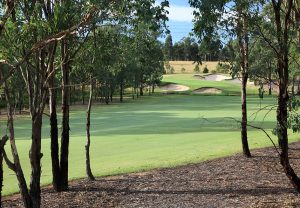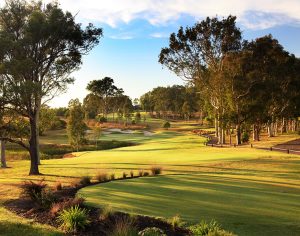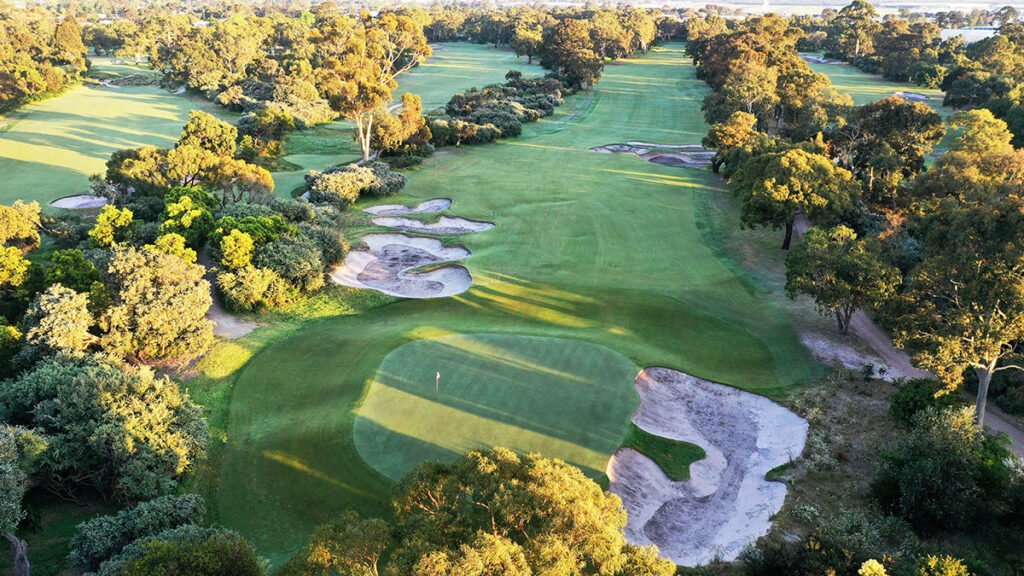WHEN news began filtering down the Hunter Valley in the late 1990s that Greg Norman was building a golf course within the Pokolbin vineyards, those of us who called the valley home at the time rejoiced. Long regarded as a popular wine-producing region and tourist hotspot in close proximity to New South Wales’ two largest cities, the Lower Hunter largely lacked other pursuits to draw people away from the ‘big smoke’.
And in January 2003 when Norman was on hand to play alongside Australian cricket legend Steve Waugh, rugby league immortal and Cessnock product Andrew Johns plus one lucky member who hit the jackpot to be drawn in the inaugural foursome, it marked the beginning of what has now been 14 years of golf richness among the vines.

The mostly clay-based soil is not as ideal for golf as sandier terrain, while Norman’s co-designer Bob Harrison lamented the way the rough initially struggled to flourish. But just like the bold shiraz Pokolbin is known for, The Vintage would mature and now boasts a full flavour. There have been a few design tweaks in the ensuing years, as the course today remains as appealing as ever. A thorough bunker refurbishment program completed by Flemming Golf, who built the bunkers originally, alongside course superintendent Steve Harris and his team during the second half of 2016 has rejuvenated the troublesome traps. Many bunkers received subtle adjustments such as raising the lip heights in places by just enough to enhance their visual influence and aesthetic value, to borrow a term from the architecture boffins.
Another recent addition is a spare hole, a par 3 nestled beside the seventh tee. The club took the opportunity to experiment with grass types for the new green, monitoring which strain performs best should they ever replace all the existing Providence SR 1019 putting surfaces. Both are likewise varieties of bentgrass, with the front half of the two-tiered green a mix of A1 and A4 and the back portion all Pure Distinction, which Harris says took longer to establish but copes with stress far better. It is the surface of choice at Royal Canberra.
Tee-to-green, the playing surfaces remain pristine. Worth noting is the subtle – and not so subtle – variation in climate in the Lower Hunter Valley compared to Sydney and even Newcastle, which is just 60 kilometres away. There’s no afternoon sea breeze to quell a hot summer’s day just as the cold of winter has a stronger bite. Golfers would do well to better understand that – and adjust their games and expectations with the time of year.
“It’s such a harsh climate up here,” Harris says. “It’s a little like [western Sydney] but 10 to 15 percent on top of that because of the extremity of hot summers and winds. The hardest thing is to project to members and golfers that you’ve got different seasons and you’ve got to manage those extremes.”
Your correspondent usually finds himself at The Vintage a couple of times a year. The summer heat can serve up some oppressive weather, while the winter days are surprisingly comfortable on the non-frosty mornings (perhaps thanks to knowing the lure of a nice red beside a roaring fireplace is the 19th-hole reward). The coming months of late summer and autumn, however, might be the pick. The fact this time of year parallels harvest period is a happy coincidence, but the golf course is also at its ripest.
Harris likes another time of year. “September’s nice,” says the only man to ever hold The Vintage’s course superintendent role. “It’s still got that little bit of crispness about the mornings and the days are just glorious.”

Mixed Dozen
One oddity to the layout is that it might be the sixth or seventh hole before you unsheathe the driver. A short and mid-length par 4 open proceedings, while the ‘big stick’ risks running out of fairway at the par-4 third and fourth holes, then the fifth is a par 3. The entire front nine is largely an exercise in patience as genuine birdie chances are rare (there’s just one par 5 on the outward half and only three in total) so caution is advised. The second hole narrows between stands of pines towards a green that’s as slender as the path required to reach it. Two holes later, those present on the opening day recall Norman taking a crack at driving the green at the 336-metre fourth with a lusty blow. Mortal golfers need to leave their tee shots precisely on the side-sloping fairway of the dogleg left to avoid the trees on the corner blocking the approach to the raised, angled putting surface.
Bimbadgen Estate vineyard flanks the iconic par-5 seventh. The broad fairway rises and falls before inclining again to reach a split-level green, with the entire 507m journey taking place with the vines only a few steps offline to the left. If you hug that side with your tee shot like I did during my most recent round at The Vintage, you might fire your second shot over the heads of a family of kangaroos munching away nonchalantly. The tilt in the front portion of the green lets imaginative players use the camber to their advantage – or their peril – with approach shots.

An equally memorable hole is the photogenic par-3 eighth where the presence of a large lake beside the green is impossible to ignore, no matter how laser-like your focus might be. A sneaky-difficult uphill par 4 at nine closes the front side before the par-5 10th flows alongside the luxurious Chateau Elan villas. The Vintage’s 10th features one of the more demanding lay-up options for a three-shotter. Many par 5s unreachable in two blows provide a fairly stress-free play for the second shot, but at the 10th there’s a pond to the left and a narrowing strip of land upon which to chew off some distance. More adventurous golfers can attempt to find the raised area above and right of the water, yet doing so is almost as difficult a path as taking a rip at the green itself.
The course then eases up slightly with little to complicate the par-4 11th and ample dry land away from the water fronting the green of the par-3 12th. Short par 4s at 13 and 15 sandwich a double-dogleg par 5 in a three-pronged set of birdie chances.
The finish ramps up the challenge via stern par 4s at the 16th and 18th plus one of the prettiest holes at The Vintage: the downhill, 182m 17th. Viewed from the high tee with the 18th hole and clubhouse in the distance beyond, the last of the short holes is magnificently framed by the flanking treelines, the target itself and the trouble surrounding it. The hazard short and left of the par 3 used to be a deep, unkempt chasm of lost balls and ugliness, but in 2010 the crater was cleaned up and filled to become a picturesque pond that contrasts neatly against the bunkers circling the back half of the putting surface. Closing the round is an uphill dogleg right that begins from a chute of tees and ends with another bunker-ringed green in front of the stately yet welcoming clubhouse.
The good news is this particular vintage has plenty more bottles left in its cellar as the course’s rich flavour continues to age with gusto.
THE DETAILS
The Vintage Golf Resort & Spa
Vintage Drive, Pokolbin NSW 2320
Phone: (02) 4998 6789





